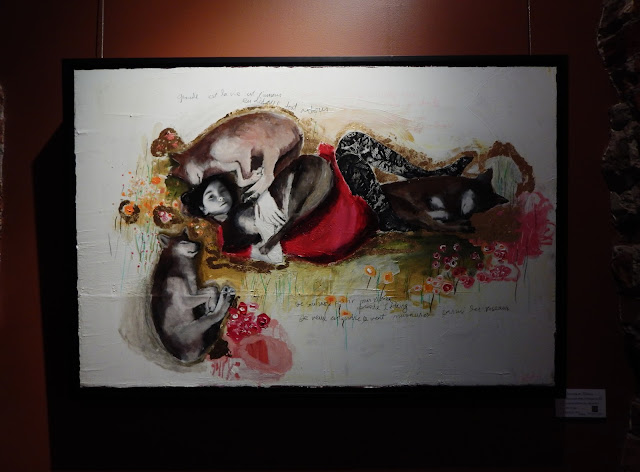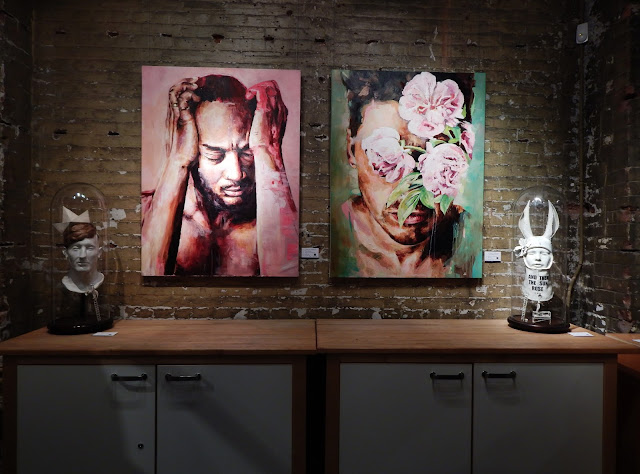This is a story about how a weeping willow gave me butterflies. Forgive me. I jest. The tree was an important landmark to my excitement however as it greeted me upon arrival to The Distillery District in Toronto where I hoped to see butterflies teasing figurative stories on Dominque Fortin's canvases.
The gallery was glowing with lit originals - flashes of art enthusiasts' silhouettes blurring by the old window panes. I could not wait to be inside. Wine glasses clinking and lovely nibbles from fancy trays moved about.
When art can make you teary you know you have found an Artist worth collecting.
Dominique Fortin is one of those Canadians with exceptional, unique talent. I love her work.
Dominique Fortin's work can be characterized as an unwavering exploration of human nature. Initially drawing from a modernist tradition, her work has evolved into a unique style that is almost dream-like, full of fantasy and romanticism, childlike innocence and raw emotion. Fortin suggests that her works, at one point, were a representation of reality, but as her artistic style has progressed, she finds herself captured within this dream-like world where the characters are not actors on a stage but rather the catalysts of unsolicited emotion.
She is inspired by the ideals of "optimistic perspectives, the delightful aesthetics" and the constant redefinition of life. She is currently influenced by individuals that listen to their heart, those that devoting themselves towards an ideal and people that are true to themselves. True to herself, Fortin has begun further introspection into her work stating, "my practice of yoga has deeply oriented my approach to life and inevitably to my work." She continues to focus on themes of childhood, and how this "paradise lost" has become found again in her own children. Fanciful, and imaginative, these paintings represent the second coming of Fortin’s youth.
Symbolism continues to be a key component of Fortin's work. Birds and butterflies are repeated throughout, serving as symbols of metamorphosis and the cyclical nature of life. In the artist's words, "they are the soul freed from its physical incarnation." Fortin has continuously focused on the reciprocity between humans and nature. This is strongly exhibited in her works where animals and humans are united. Fortin has found an artistic language that is unique; by adding text and various techniques such as gilding, image transfer and fabrics, each work is visually rich with layers of texture with room for multiple interpretations. These techniques and concepts allow Fortin to create pieces that not only echo her optimistic, romantic ideals but allow her to speak symbolically through her artwork.
The evening was a spectacular - warm and inviting event; The Vernissage. You may wonder about this word and its historical context within the art world.
A vernissage (from French, originally meaning “varnishing”) is a term used for a preview of an art exhibition, which may be private, before the formal opening. If the vernissage is not open to the public, but only for invited guests, it is often called a private view.
At official exhibitions in the nineteenth century, such as the Royal Academy summer exhibition, artists would give a finishing touch to their works by varnishing them. The custom of patrons and the élite of visiting the academies during the varnishing day prior to the formal opening of the exhibition gave rise to the tradition of celebrating the completion of an art work or a series of art works with friends and sponsors. In the twentieth century it became an opportunity to market the works on view to buyers and critics.
There is a comparable ceremonial ending of art exhibitions, called a finissage. Larger art exhibitions also may have an event at half time of the exhibition called a midissage. These latter terms are rare in English; they are more commonly used in German but not in French.
Opened in March of 2006, the Thompson Landry Gallery is one of the newest additions to the arts community at the Historic Distillery District. Pioneering new ground for galleries in Toronto, the Thompson Landry Gallery showcases both the very best of the new generation of contemporary artists, as well as the great masters of Quebec. Housed in a beautiful 2700 square foot space in the Stone Distillery Building, it is the only gallery in Toronto specializing purely in Quebec artists and sculptors.
The fourteen foot limestone walls, of the Stone Distillery create a distinctive backdrop for the striking large scale works of their internationally acclaimed contemporary artists. The impressive collection of the great masters, are housed in a room of their own. They are displayed in such a manner as though they have always belonged there. Using the historical artefacts in the space to create a unique ambiance, the Thompson Landry Gallery sets a new standard in achieving a warm and inviting atmosphere for their clients.
Thanks to the gallery for inviting me to this special group exhibition. I hope everyone gets a chance to visit soon. It is a thrilling, friendly and wondrous place to be.
A magical moment of celebration - 10th Anniversary - was the live painting on this black canvas.
An Artist smudged what seemed to be vaseline and tossed what seemed to be coconut (?) to reveal this famous face! Great applause, smiles and laughter followed.
Nearly 10 years ago a small group of visionary developers had a dream for Toronto. They looked at a derelict collection of Victorian Industrial buildings that had been pronounced a national historic site and imagined transforming it. Not into another “historic district” or “pioneer village” but into something exciting and unique. Something the city would be proud of. They wanted to create a place that would excite and inspire the senses. Where people could experience new ideas, new foods, new designs and new ways of living and working.
“Our vision was to combine the romance and relaxing atmosphere of European walking and patio districts with the hip, cool dynamic of an area like New York City’s SoHo or Chelsea, where creative minds get together and you feel as if anything could happen.”
Their dream was to provide a place where creativity would flourish and passion would be aroused – where artists, artisans, entrepreneurs and businesspeople could rub shoulders and inspire each other. So they began plans to restore the 47 buildings known as the Gooderham & Worts Distillery.
They harnessed the talent of hundreds of tradesmen and craftsmen who were skilled in working with 19th century timber, planks, stone and brick. They went to great lengths in the restoration process to repurpose original materials and brilliantly blend them with today’s modern materials and green technologies.
The result is nothing short of perfection. As the Toronto Star says: “To enter The Distillery is to step back into an era of horse-drawn carts, windmills and sailing ships”. One can only marvel at the authentic exterior restoration that was achieved. But it is when you step inside the buildings that you truly realize the magnitude of what was accomplished.
What you will find is a dramatic fusion of old and new. An inspired blend of Victorian Industrial architecture and stunning 21st century design and creativity. The result is an internationally acclaimed village of one-of-a-kind stores, shops, galleries, studios, restaurants, cafes, theatres and more.
The Distillery Historic District opened in 2003 and today it is widely regarded as Canada’s premier arts, culture and entertainment destination. A place brimming with creativity and creative people, that can inspire dreams, and a place that can help them come true.

Stone Building, 32 Distillery Lane
& The Cooperage Space, 6 Trinity Street
Toronto, Ontario, M5A 3C4
Tel: 416-364-4955
Fax: 416-364-4866
Hours: Tuesday - Saturday 11am - 6pm,
Sunday 12pm - 5pm – or by appointment




















































